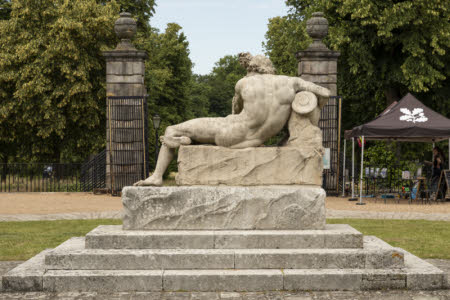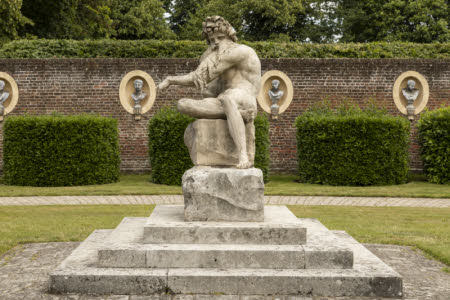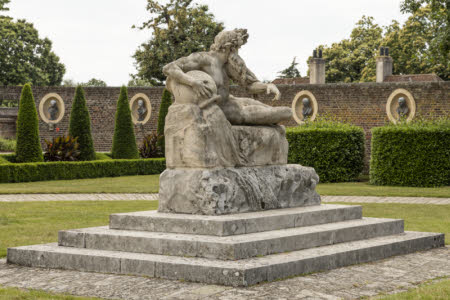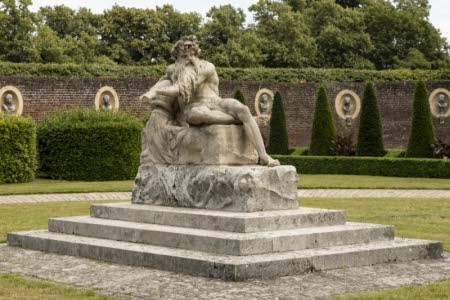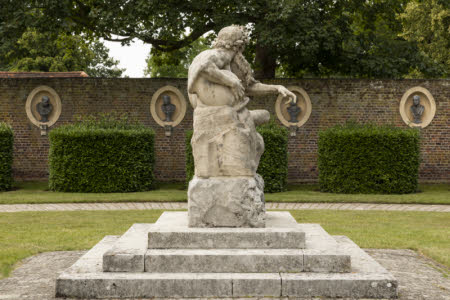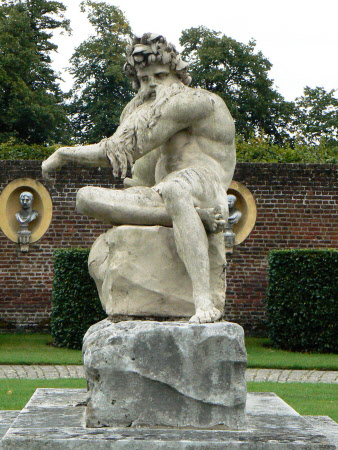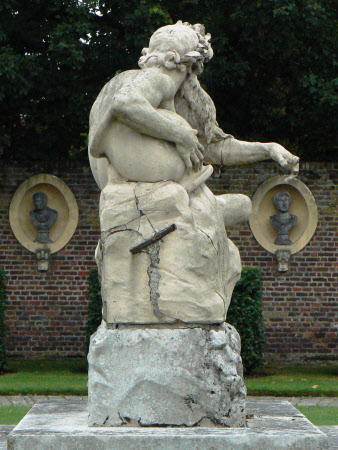Father Thames as a River God
John Bacon the Elder (London 1740 - London 1799)
Category
Art / Sculpture
Date
1779 (model)
Materials
Coade stone, Marble
Measurements
2000 mm (H)2200 mm (W)1080 mm (D)
Place of origin
Lambeth
Order this imageCollection
Ham House, Surrey
NT 1140390
Summary
A personification of Father Thames in the form of a colossal figure of a bearded river god, holding an urn from which pours a stream of water. The model was made by the sculptor John Bacon the Elder (London 1740-- London 1799) in 1779, when he was working as the chief modeller at the artificial stone manufactory established in Lambeth by the Coade family and run over many years by Mrs Eleanor Coade (Exeter 1733 – London 1821). Father Thames reclines on a plinth bearing a shield with the arms of the City of London accompanied by the Cap of Liberty and the City Chamberlain’s purse, referring to the election of the radical politician John Wilkes (1725-97) to the post of City Chamberlain in 1779.
Full description
Father Thames in the form of a river god, made in Coade stone, after a model by John Bacon the Elder (London 1740-1799. A colossal reclining male nude figure seated upon a rectangular rock, with his right leg crossed under the left, looking forwards. His right arm cradles a large urn, from which gushes water, whilst his left arm is crossed in front of him, finger of his left hand pointing downwards. The river god is luxuriantly bearded and wears around his head a wreath consisting of fruit and flowers, including the yellow water lily, also commonly known as the brandy bottle plant because of the distinctive shape of its fruit. The base bears a shield with the arms of the City of London and a trophy. Several toes and fingers of left hand replaced. This magnificent work was the largest sculpture offered in the 1784 catalogue of Eleanor Coade’s manufactory in Lambeth, south London. Mrs Coade established her factory in around 1770 and it continued to operate for some years after her death in 1821 (for coade stone, see Alison Kelly, Mrs Coade’s Stone, Upton-upon-Severn 1990; Caroline Stanford, ‘Revisiting the origins of Coade Stone’, The Georgian Group Journal, XXIV (2016), pp. 95–116). Although various forms of artificial stone had long been known, Eleanor Coade succeeded in developing a highly successful formula for a clay-based compound which, when fired and vitrified, became an extremely hard-wearing stoneware. Coade stone objects were produced starting with a model, from which moulds were made, allowing the model to be reproduced multiple times. A model in the clay compound was cast in the moulds and then fired. Coade stone was used to make a very wide range of objects, from sculptures on a large and small scale, to vases and other garden ornaments, to large architectural features. Its toughness as a material, seen in the remarkably well-preserved surface of the Ham House River God, as well as its relative cheapness compared to carved stone, were important points that helped ensure Coade stone’s success with architects and sculptors in the decades around 1800. The River God was designed and modelled by the sculptor John Bacon the Elder, who in 1771 was appointed superintendent of the Coade manufactory and was responsible for many of the form’s early models. Bacon, who was already in the 1760s working with Eleanor Coade’s early partner in the business, Daniel Pincot, may in fact have been largely responsible for developing the formula for Coade stone and perfecting its firing. The River God was in existence by 1784, when a catalogue of the Coade manufactory’s products was published. It was not only the first item in the catalogue, described as ‘A River God, with an Urn, through which a Stream of Water may be carried… a nine-foot Figure’, but also, retailing at 100 guineas (£105), by a long way the most expensive. An example of the River God is also to be seen in an engraving of the Coade manufactory’s kiln as well as in a print of the factory yard published in the 1790s (Kelly, Mrs Coade’s Stone, pp. 62 and 46). An etching, sometimes attributed to William Blake, also depicts the River God, including the badge of the City of London which identifies it as a personification of Father Thames, and is one of a series of designs from c. 1777-79 that were circulated in the form of prints. John Bacon exhibited a ‘Figure of Thames, Colossal’ at the Royal Society of Arts in 1777, for which he received a prize. This was probably an early version of the River God. The model for the example at Ham House can be dated more precisely, to 1779, thanks to the coat-of-arms on the front, in which the badge of the City of London is accompanied by the Cap of Liberty and the City Chamberlain’s purse, both on sticks. These refer to the radical politician John Wilkes (1725-97) who became City Chamberlain in 1779, and who is depicted in the celebrated engraving by William Hogarth published in 1763 holding a stick with the Cap of Liberty. Evolving from the ancient headgear known as Phrygian caps, the Cap of Liberty came to signify freedom and the pursuit of liberty, firstly in the American Revolution and then subsequently in the French Revolution.In the same year 1779, as part of a competition set by the City of London, John Bacon the Elder made six designs for a splendid Freedom Box presented by the City to Admiral Keppel (designs in Victoria & Albert Museum, box in the Museum of London). The version of the River God at Ham House was installed at the front of the house by Wilbrahim Tollemache, 6th Earl of Dysart, between 1799-1803, when the north front of the house was opened up to the river. A watercolour by Thomas Rowlandson dated 1803 shows the River God in situ before the house (Rowell, Ham House. 400 Years of History, p. 361, fig. 371). Another example of the River God was formerly at Llewenni Hall in Denbighshire, where it was paired with a figure by Bacon of a reclining water nymph (Kelly, Mrs Coade’s Stone, pp. 128-29), whilst there is a damaged example in the Terrace Gardens, Richmond. A slightly later version of the water nymph, by now called Sabrina and dated 1802, is at Croome Court (NT 105007). John Bacon reprised his figure of the River God in bronze for his monumental group depicting King George III and the River Thames, made for the courtyard of Somerset House in 1789 and still in situ today. Jeremy WarrenJanuary 2022
Provenance
Acquired by by Wilbrahim Tollemache, 6th Earl of Dysart, between 1799-1803.Thence by descent, until acquired in 1948 by HM Government when Sir Lyonel, 4th Bt (1854 – 1952) and Sir Cecil Tollemache, 5th Bt (1886 – 1969) presented Ham House to the National Trust. Entrusted to the care of the Victoria & Albert Museum until 1990, when returned to the care of the National Trust, to which ownership was transferred in 2002.
Marks and inscriptions
On front of base, below River God’s right thigh: COADE LAMBETH
Makers and roles
John Bacon the Elder (London 1740 - London 1799), sculptor Coade, stoneware manufacturer after John Bacon the Younger (London 1777 - London 1859), sculptor
References
Whinney 1992: Margaret D. Whinney, Sculpture in Britain, 1530-1830, Yale University Press, 1992, p. 303. Kelly 1990: Alison Kelly, Mrs Coade's stone, Upton-upon-Severn 1990, frontispiece, pp. 43, 45, 61-62, 127, 315. Roscoe 2009: I. Roscoe, E. Hardy and M. G. Sullivan, A Biographical Dictionary of Sculptors in Britain 1660-1851, New Haven and Yale 2009, p. 41, no. 139. Rowell 2013: Christopher Rowell (ed.), Ham House, 400 Years of Collecting and Patronage, Yale University Press, New Haven & London 2013, pp. 360-61, fig. 370.

